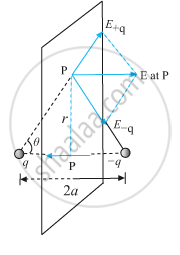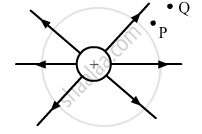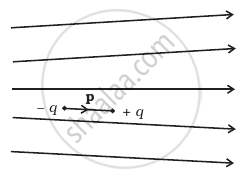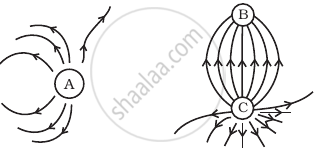Advertisements
Advertisements
Question
Answer the following question.
Derive an expression for the electric field due to a dipole of dipole moment `vec"p"` at a point on its perpendicular bisector.
Solution

The magnitudes of the electric field due to the two charges +q and −q are given by,
`E_(+q) = ("q")/(4πε_0) (1)/("r"^2 + a^2)` .....(i)
`E_(-q) = ("q")/(4πε_0) (1)/("r"^2 + a^2)` .....(i)
∴ `E_(+q) = E_(-q)`
The directions of E+q and E−q are as shown in the figure. The components normal to the dipole axis cancel away. The components along the dipole axis add up.
∴ Total electric field
`E = -(E_+q + E_-q) cos theta hat"p" ... ["negative sign shows that field is opposite to" hat"p"]`
`E = -(2qa)/(4πε_0("r"^2 + a^2)^(3/2)) hat"p"` ....(iii)
At large distances (r >> a), this reduces to
`E = -(2qa)/(4πε_0"r"^3)hat"p"` ....(iv)
∵ `vec"p" = q xx vec"2a"hat"p"`
∴ `E = (-vec"p")/(4πε_0"r"^3)` ...(r>>a).
APPEARS IN
RELATED QUESTIONS
Why do the electrostatic field lines not form closed loops?
(a) Derive an expression for the electric field E due to a dipole of length '2a' at a point distant r from the centre of the dipole on the axial line.
(b) Draw a graph of E versus r for r >> a.
(c) If this dipole were kept in a uniform external electric field E0, diagrammatically represent the position of the dipole in stable and unstable equilibrium and write the expressions for the torque acting on the dipole in both the cases.
The figure shows the field lines on a positive charge. Is the work done by the field in moving a small positive charge from Q to P positive or negative? Give reason.

Two bar magnets are quickly moved towards a metallic loop connected across a capacitor ‘C’ as shown in the figure. Predict the polarity of the capacitor.

A thin, metallic spherical shell contains a charge Q on it. A point charge q is placed at the centre of the shell and another charge q1 is placed outside it as shown in the following figure. All the three charges are positive. The force on the central charge due to the shell is ______.
The intensity of the electric field at a perpendicular distance of 0·5 m from an infinitely long line charge having linear charge density (λ) is 3-6 × 103 Vm-1. Find the value of λ.
Answer the following question.
Draw the pattern of electric field lines when a point charge +q is kept near an uncharged conducting plate.
Figure shows electric field lines in which an electric dipole P is placed as shown. Which of the following statements is correct?

If Ea be the electric field strength of a short dipole at a point on its axial line and Ee that on the equatorial line at the same distance, then:
Figure shows the electric field lines around three point charges A, B and C.

- Which charges are positive?
- Which charge has the largest magnitude? Why?
- In which region or regions of the picture could the electric field be zero? Justify your answer.
(i) near A, (ii) near B, (iii) near C, (iv) nowhere.
